DODGE JOURNEY 2010 1.G Owner's Guide
Manufacturer: DODGE, Model Year: 2010, Model line: JOURNEY, Model: DODGE JOURNEY 2010 1.GPages: 512
Page 31 of 512
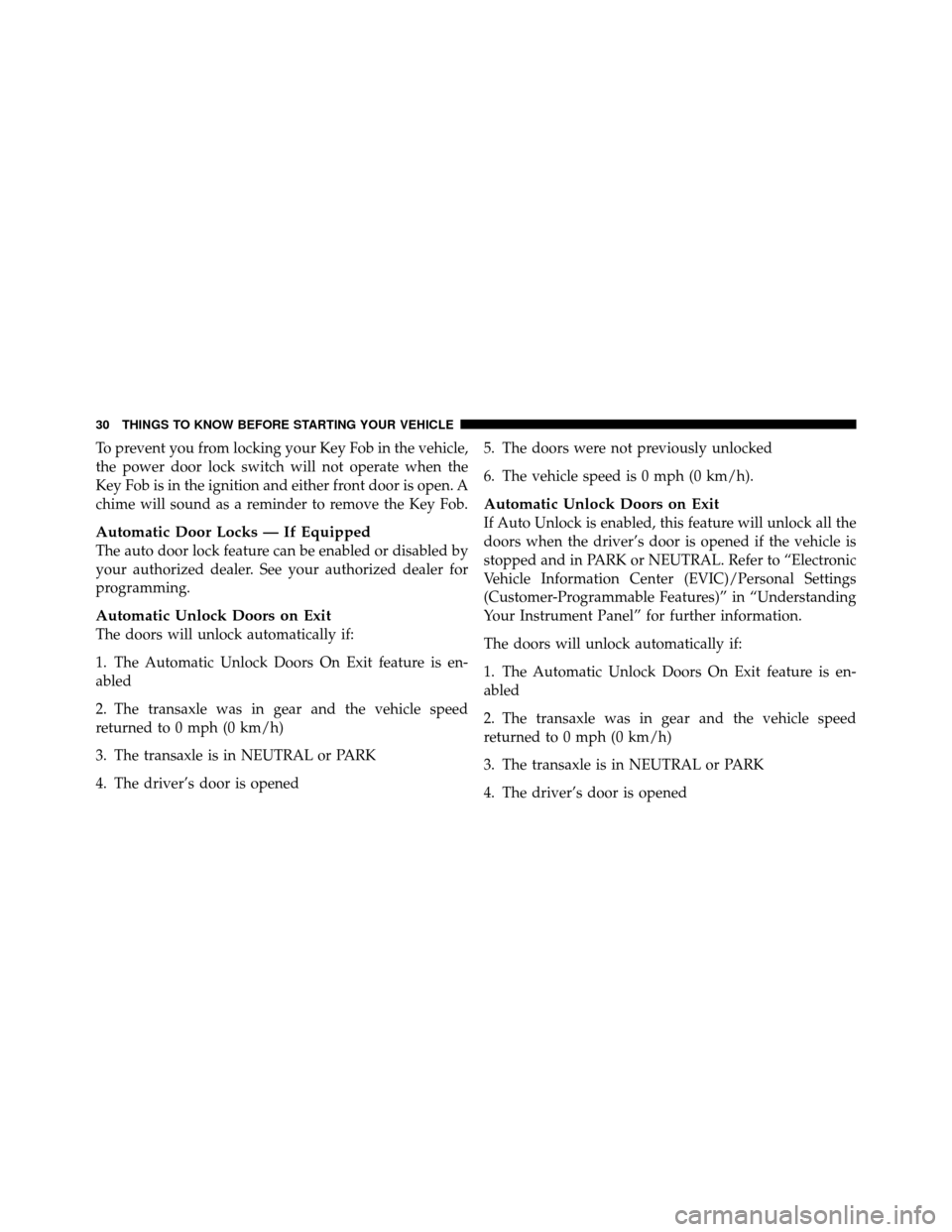
To prevent you from locking your Key Fob in the vehicle,
the power door lock switch will not operate when the
Key Fob is in the ignition and either front door is open. A
chime will sound as a reminder to remove the Key Fob.
Automatic Door Locks — If Equipped
The auto door lock feature can be enabled or disabled by
your authorized dealer. See your authorized dealer for
programming.
Automatic Unlock Doors on Exit
The doors will unlock automatically if:
1. The Automatic Unlock Doors On Exit feature is en-
abled
2. The transaxle was in gear and the vehicle speed
returned to 0 mph (0 km/h)
3. The transaxle is in NEUTRAL or PARK
4. The driver’s door is opened5. The doors were not previously unlocked
6. The vehicle speed is 0 mph (0 km/h).
Automatic Unlock Doors on Exit
If Auto Unlock is enabled, this feature will unlock all the
doors when the driver’s door is opened if the vehicle is
stopped and in PARK or NEUTRAL. Refer to “Electronic
Vehicle Information Center (EVIC)/Personal Settings
(Customer-Programmable Features)” in “Understanding
Your Instrument Panel” for further information.
The doors will unlock automatically if:
1. The Automatic Unlock Doors On Exit feature is en-
abled
2. The transaxle was in gear and the vehicle speed
returned to 0 mph (0 km/h)
3. The transaxle is in NEUTRAL or PARK
4. The driver’s door is opened
30 THINGS TO KNOW BEFORE STARTING YOUR VEHICLE
Page 32 of 512
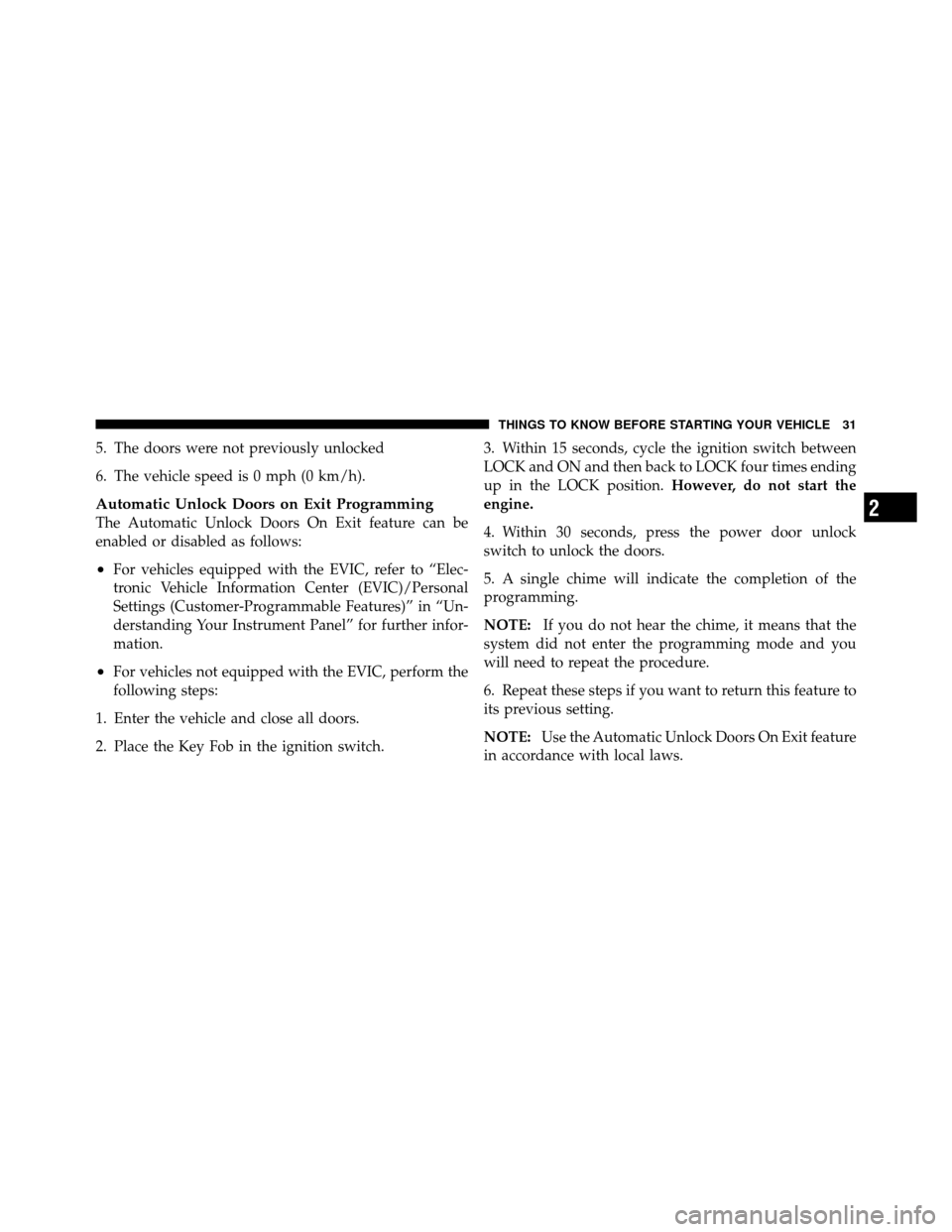
5. The doors were not previously unlocked
6. The vehicle speed is 0 mph (0 km/h).
Automatic Unlock Doors on Exit Programming
The Automatic Unlock Doors On Exit feature can be
enabled or disabled as follows:
•For vehicles equipped with the EVIC, refer to “Elec-
tronic Vehicle Information Center (EVIC)/Personal
Settings (Customer-Programmable Features)” in “Un-
derstanding Your Instrument Panel” for further infor-
mation.
•For vehicles not equipped with the EVIC, perform the
following steps:
1. Enter the vehicle and close all doors.
2. Place the Key Fob in the ignition switch. 3. Within 15 seconds, cycle the ignition switch between
LOCK and ON and then back to LOCK four times ending
up in the LOCK position.
However, do not start the
engine.
4. Within 30 seconds, press the power door unlock
switch to unlock the doors.
5. A single chime will indicate the completion of the
programming.
NOTE: If you do not hear the chime, it means that the
system did not enter the programming mode and you
will need to repeat the procedure.
6. Repeat these steps if you want to return this feature to
its previous setting.
NOTE: Use the Automatic Unlock Doors On Exit feature
in accordance with local laws.
2
THINGS TO KNOW BEFORE STARTING YOUR VEHICLE 31
Page 33 of 512
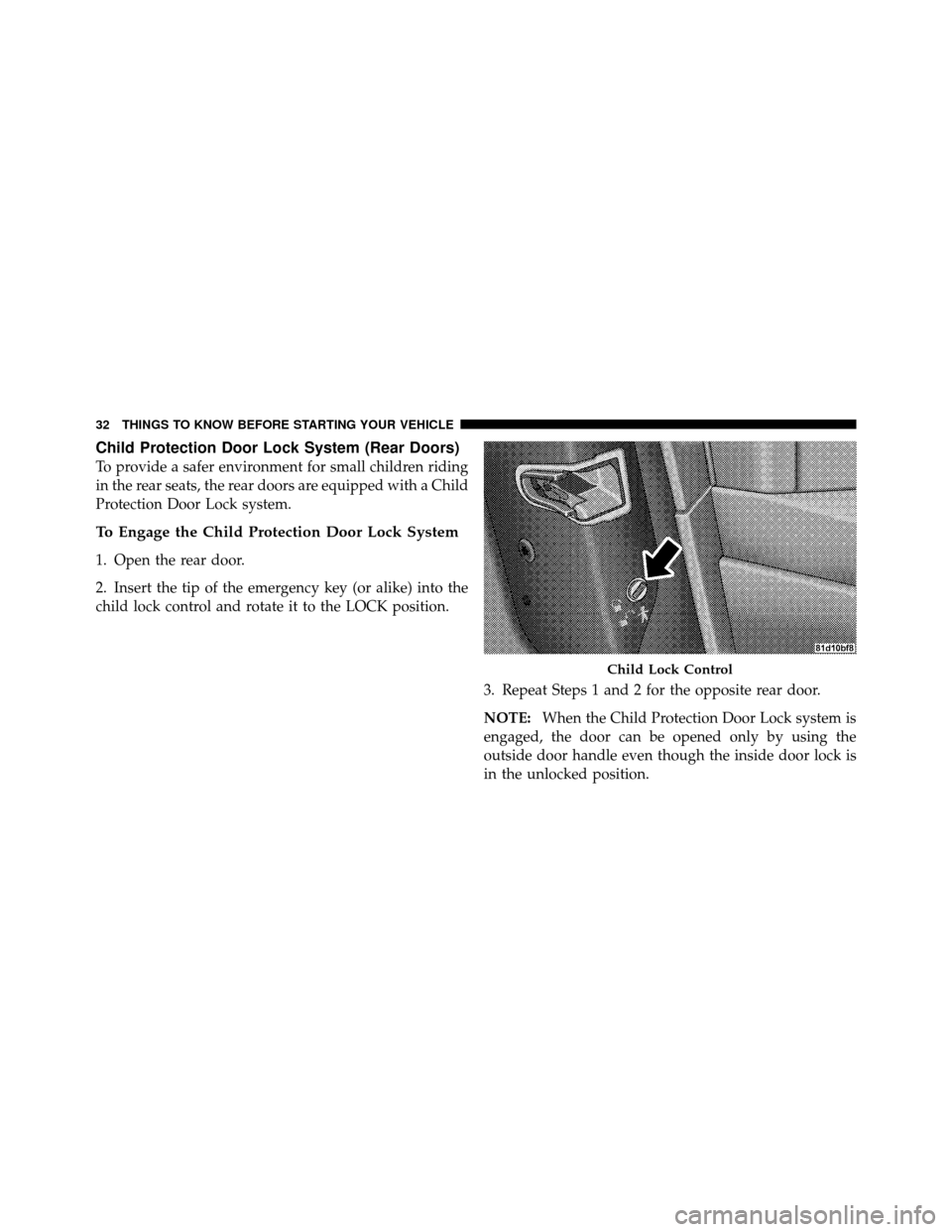
Child Protection Door Lock System (Rear Doors)
To provide a safer environment for small children riding
in the rear seats, the rear doors are equipped with a Child
Protection Door Lock system.
To Engage the Child Protection Door Lock System
1. Open the rear door.
2. Insert the tip of the emergency key (or alike) into the
child lock control and rotate it to the LOCK position.3. Repeat Steps 1 and 2 for the opposite rear door.
NOTE:When the Child Protection Door Lock system is
engaged, the door can be opened only by using the
outside door handle even though the inside door lock is
in the unlocked position.
Child Lock Control
32 THINGS TO KNOW BEFORE STARTING YOUR VEHICLE
Page 34 of 512
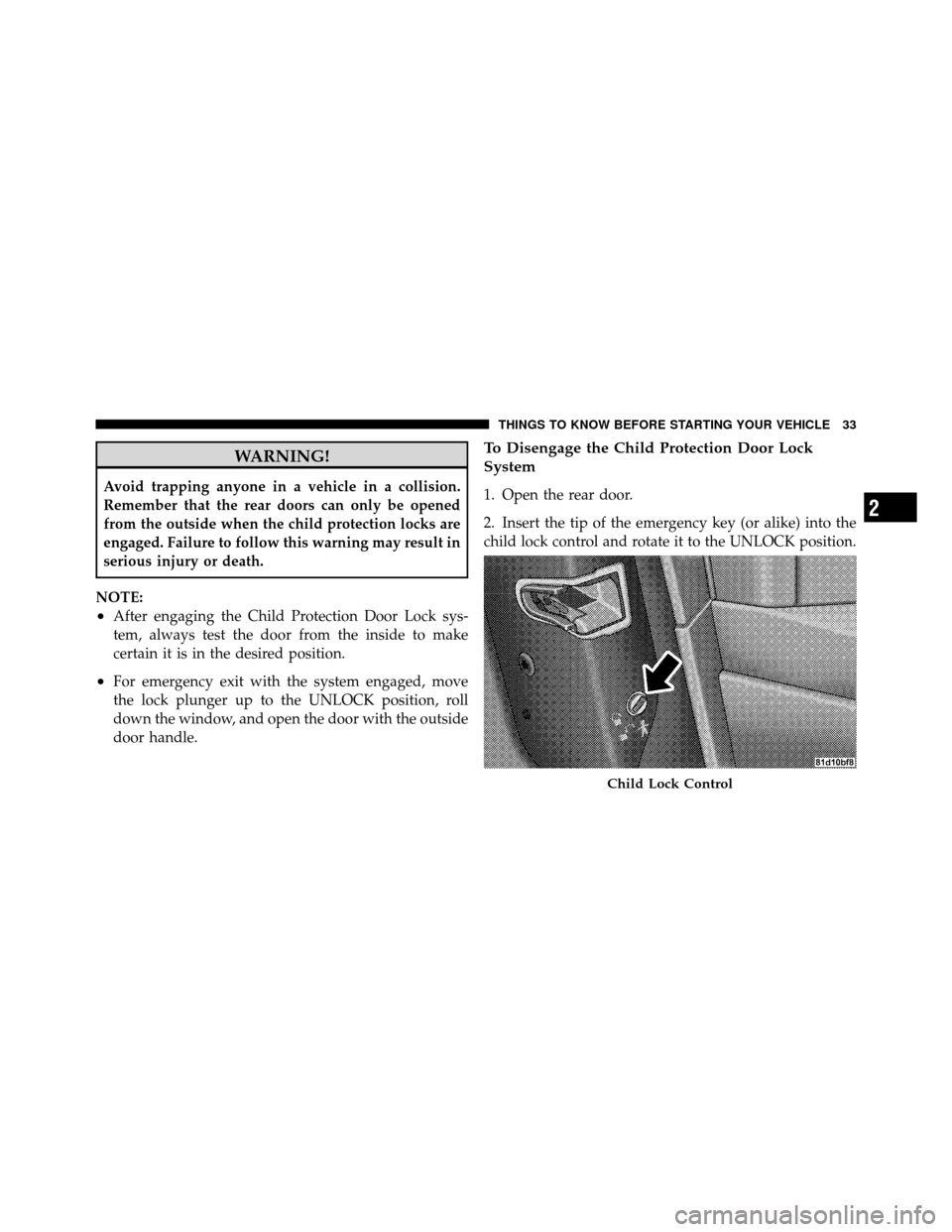
WARNING!
Avoid trapping anyone in a vehicle in a collision.
Remember that the rear doors can only be opened
from the outside when the child protection locks are
engaged. Failure to follow this warning may result in
serious injury or death.
NOTE:
•After engaging the Child Protection Door Lock sys-
tem, always test the door from the inside to make
certain it is in the desired position.
•For emergency exit with the system engaged, move
the lock plunger up to the UNLOCK position, roll
down the window, and open the door with the outside
door handle.
To Disengage the Child Protection Door Lock
System
1. Open the rear door.
2. Insert the tip of the emergency key (or alike) into the
child lock control and rotate it to the UNLOCK position.
Child Lock Control
2
THINGS TO KNOW BEFORE STARTING YOUR VEHICLE 33
Page 35 of 512
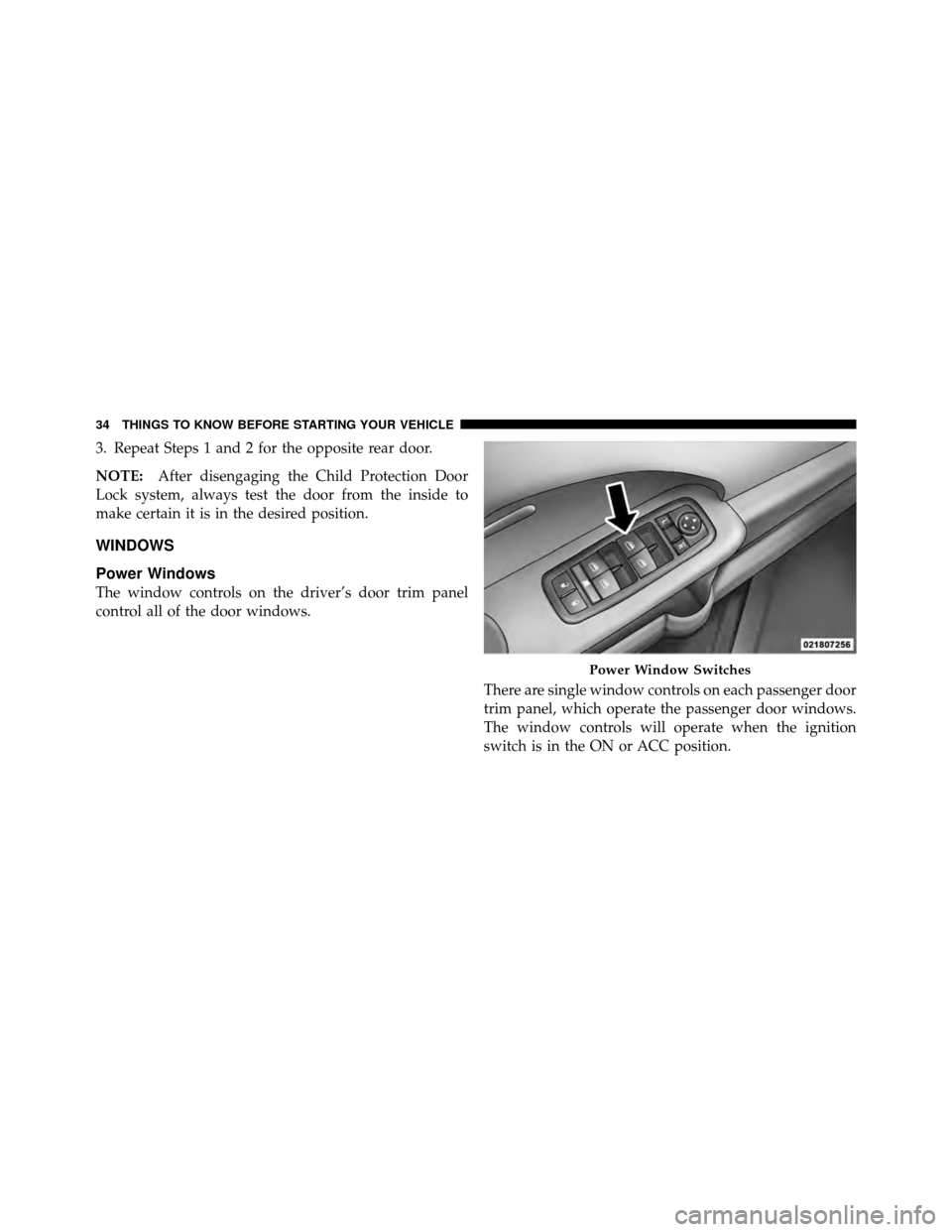
3. Repeat Steps 1 and 2 for the opposite rear door.
NOTE:After disengaging the Child Protection Door
Lock system, always test the door from the inside to
make certain it is in the desired position.
WINDOWS
Power Windows
The window controls on the driver’s door trim panel
control all of the door windows.
There are single window controls on each passenger door
trim panel, which operate the passenger door windows.
The window controls will operate when the ignition
switch is in the ON or ACC position.
Power Window Switches
34 THINGS TO KNOW BEFORE STARTING YOUR VEHICLE
Page 36 of 512
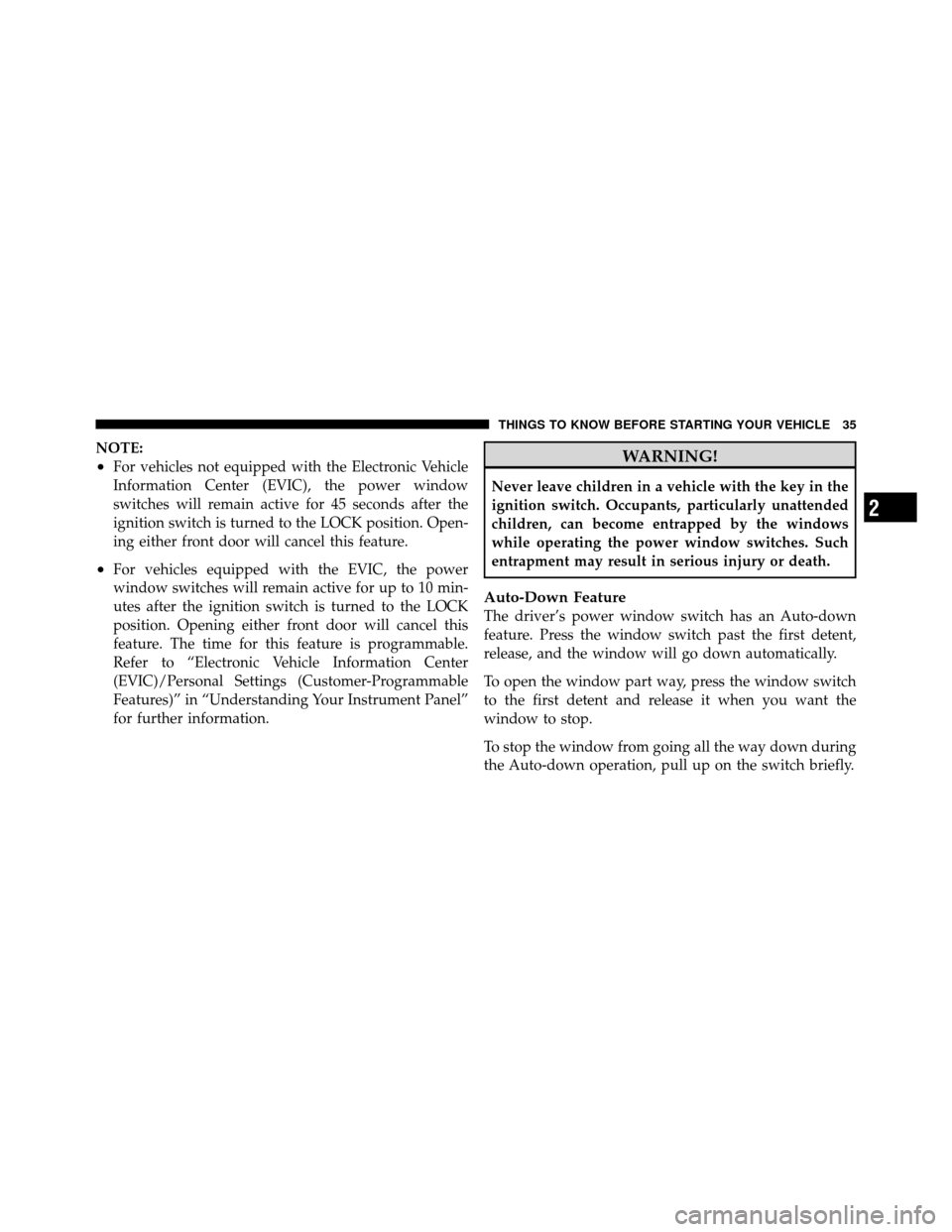
NOTE:
•For vehicles not equipped with the Electronic Vehicle
Information Center (EVIC), the power window
switches will remain active for 45 seconds after the
ignition switch is turned to the LOCK position. Open-
ing either front door will cancel this feature.
•For vehicles equipped with the EVIC, the power
window switches will remain active for up to 10 min-
utes after the ignition switch is turned to the LOCK
position. Opening either front door will cancel this
feature. The time for this feature is programmable.
Refer to “Electronic Vehicle Information Center
(EVIC)/Personal Settings (Customer-Programmable
Features)” in “Understanding Your Instrument Panel”
for further information.
WARNING!
Never leave children in a vehicle with the key in the
ignition switch. Occupants, particularly unattended
children, can become entrapped by the windows
while operating the power window switches. Such
entrapment may result in serious injury or death.
Auto-Down Feature
The driver’s power window switch has an Auto-down
feature. Press the window switch past the first detent,
release, and the window will go down automatically.
To open the window part way, press the window switch
to the first detent and release it when you want the
window to stop.
To stop the window from going all the way down during
the Auto-down operation, pull up on the switch briefly.
2
THINGS TO KNOW BEFORE STARTING YOUR VEHICLE 35
Page 37 of 512
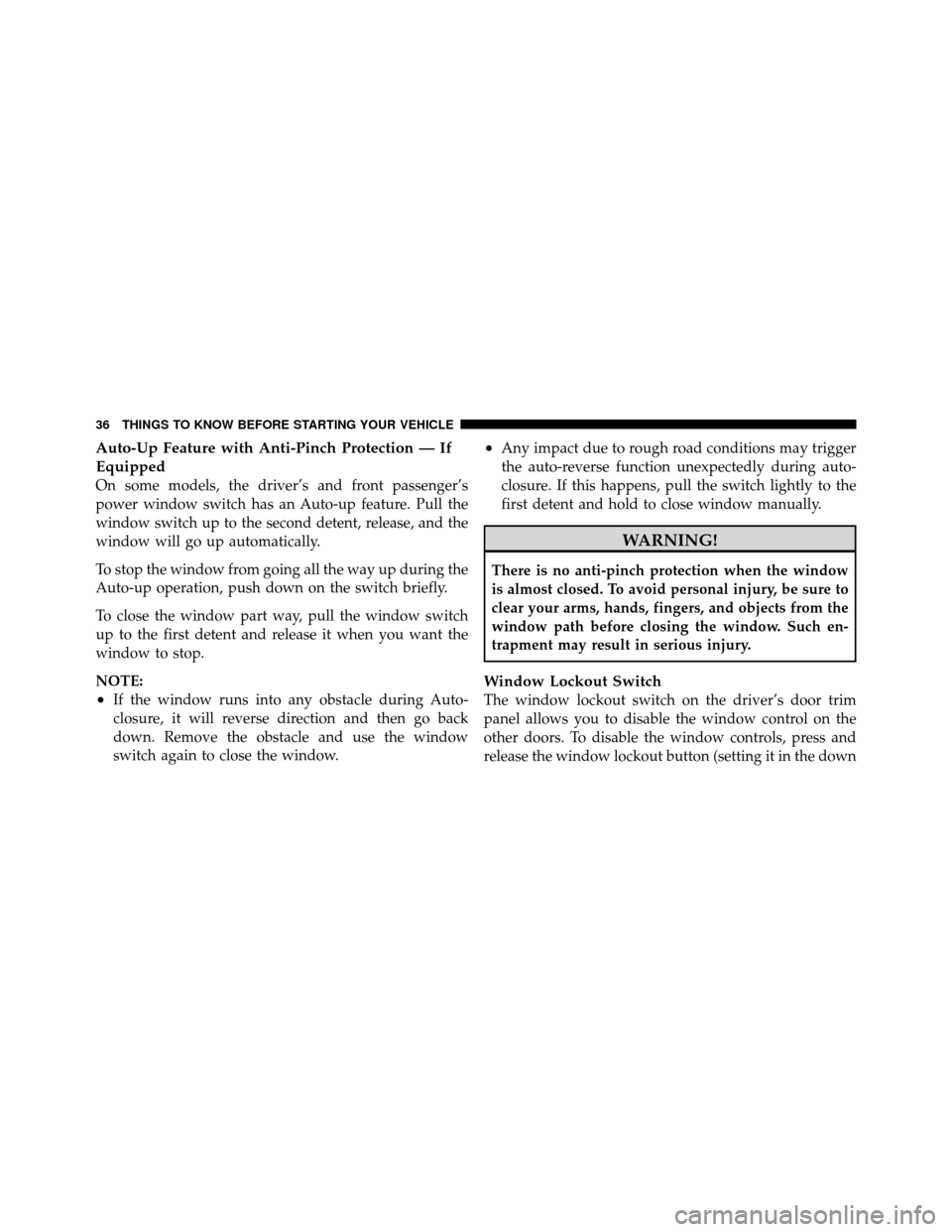
Auto-Up Feature with Anti-Pinch Protection — If
Equipped
On some models, the driver’s and front passenger’s
power window switch has an Auto-up feature. Pull the
window switch up to the second detent, release, and the
window will go up automatically.
To stop the window from going all the way up during the
Auto-up operation, push down on the switch briefly.
To close the window part way, pull the window switch
up to the first detent and release it when you want the
window to stop.
NOTE:
•If the window runs into any obstacle during Auto-
closure, it will reverse direction and then go back
down. Remove the obstacle and use the window
switch again to close the window.
•Any impact due to rough road conditions may trigger
the auto-reverse function unexpectedly during auto-
closure. If this happens, pull the switch lightly to the
first detent and hold to close window manually.
WARNING!
There is no anti-pinch protection when the window
is almost closed. To avoid personal injury, be sure to
clear your arms, hands, fingers, and objects from the
window path before closing the window. Such en-
trapment may result in serious injury.
Window Lockout Switch
The window lockout switch on the driver’s door trim
panel allows you to disable the window control on the
other doors. To disable the window controls, press and
release the window lockout button (setting it in the down
36 THINGS TO KNOW BEFORE STARTING YOUR VEHICLE
Page 38 of 512
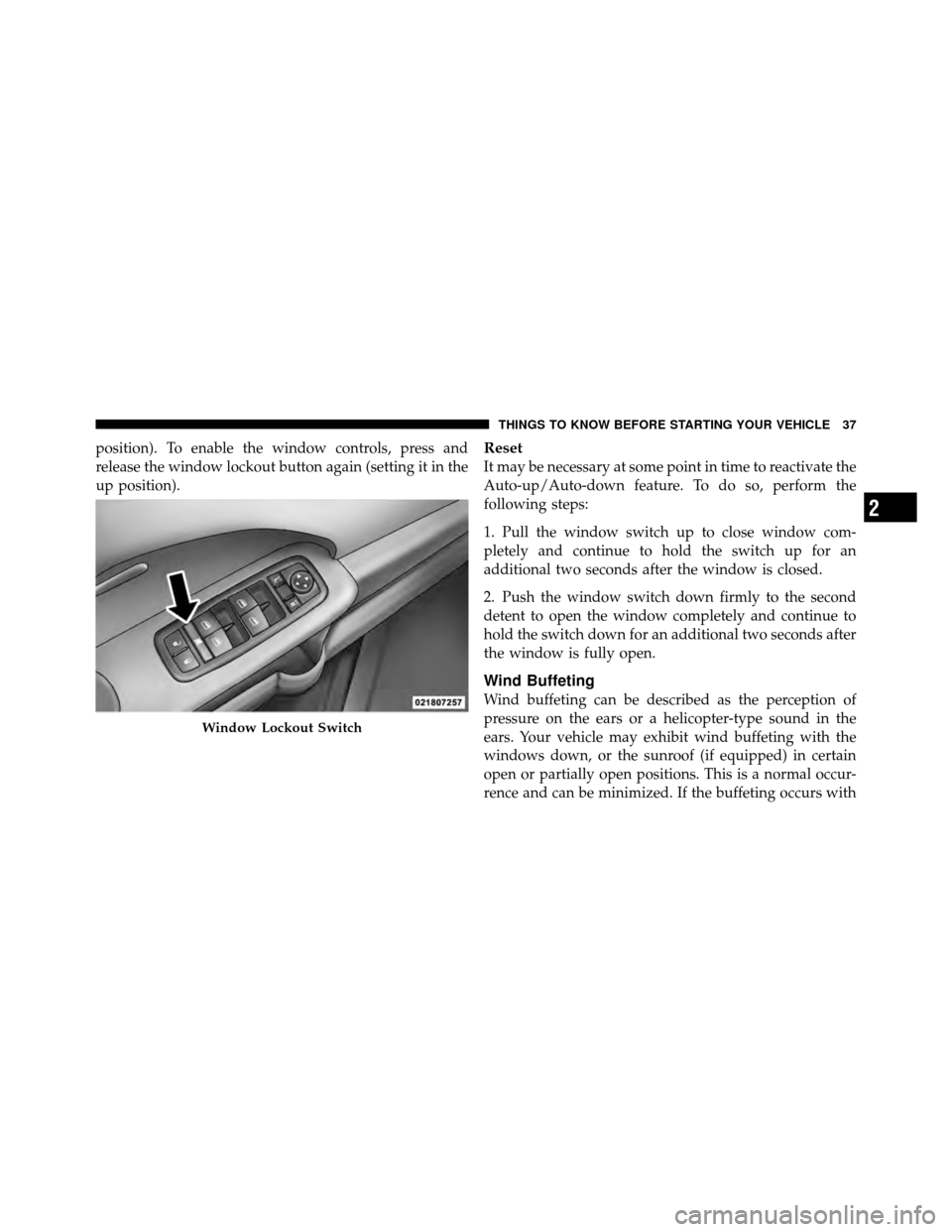
position). To enable the window controls, press and
release the window lockout button again (setting it in the
up position).Reset
It may be necessary at some point in time to reactivate the
Auto-up/Auto-down feature. To do so, perform the
following steps:
1. Pull the window switch up to close window com-
pletely and continue to hold the switch up for an
additional two seconds after the window is closed.
2. Push the window switch down firmly to the second
detent to open the window completely and continue to
hold the switch down for an additional two seconds after
the window is fully open.
Wind Buffeting
Wind buffeting can be described as the perception of
pressure on the ears or a helicopter-type sound in the
ears. Your vehicle may exhibit wind buffeting with the
windows down, or the sunroof (if equipped) in certain
open or partially open positions. This is a normal occur-
rence and can be minimized. If the buffeting occurs with
Window Lockout Switch
2
THINGS TO KNOW BEFORE STARTING YOUR VEHICLE 37
Page 39 of 512
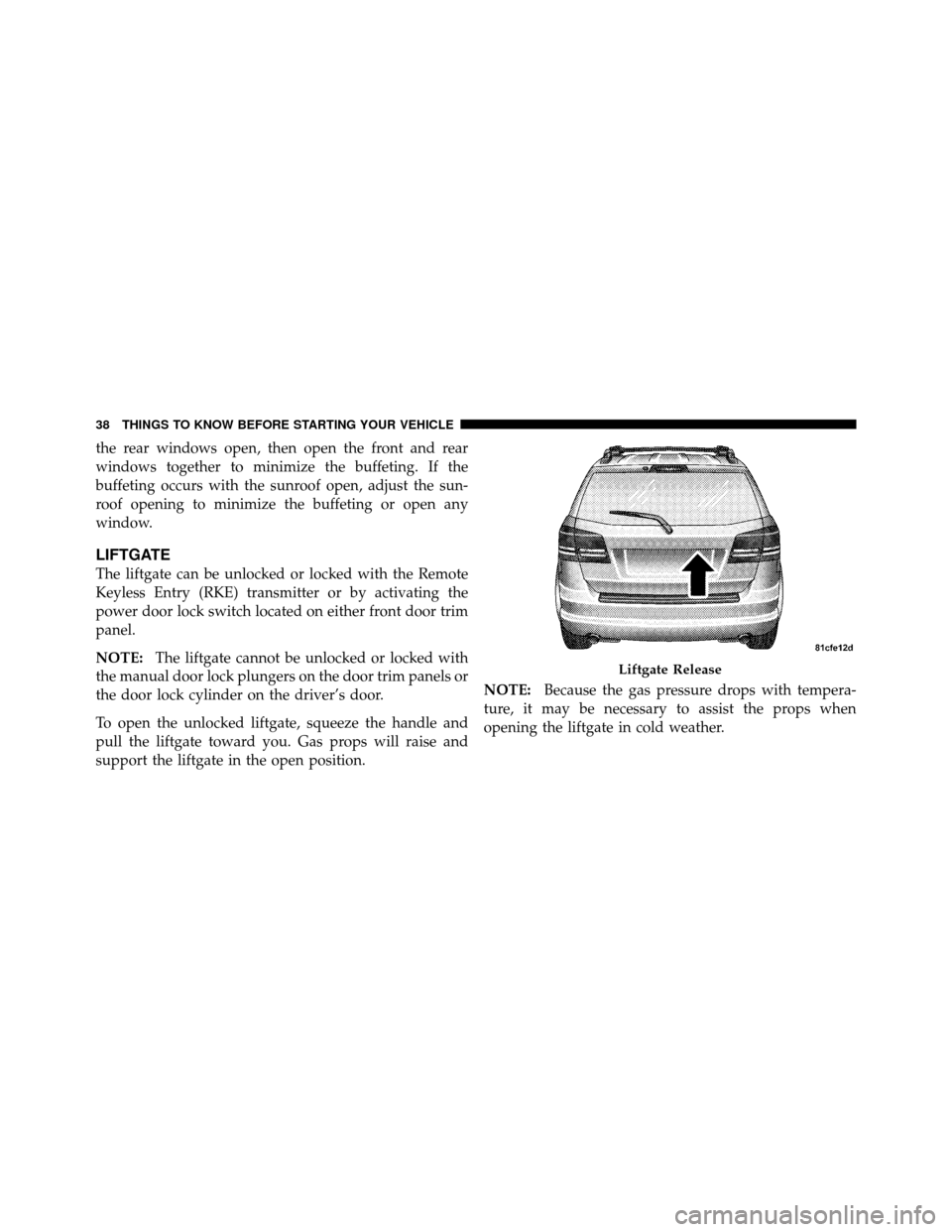
the rear windows open, then open the front and rear
windows together to minimize the buffeting. If the
buffeting occurs with the sunroof open, adjust the sun-
roof opening to minimize the buffeting or open any
window.
LIFTGATE
The liftgate can be unlocked or locked with the Remote
Keyless Entry (RKE) transmitter or by activating the
power door lock switch located on either front door trim
panel.
NOTE:The liftgate cannot be unlocked or locked with
the manual door lock plungers on the door trim panels or
the door lock cylinder on the driver’s door.
To open the unlocked liftgate, squeeze the handle and
pull the liftgate toward you. Gas props will raise and
support the liftgate in the open position. NOTE:
Because the gas pressure drops with tempera-
ture, it may be necessary to assist the props when
opening the liftgate in cold weather.
Liftgate Release
38 THINGS TO KNOW BEFORE STARTING YOUR VEHICLE
Page 40 of 512
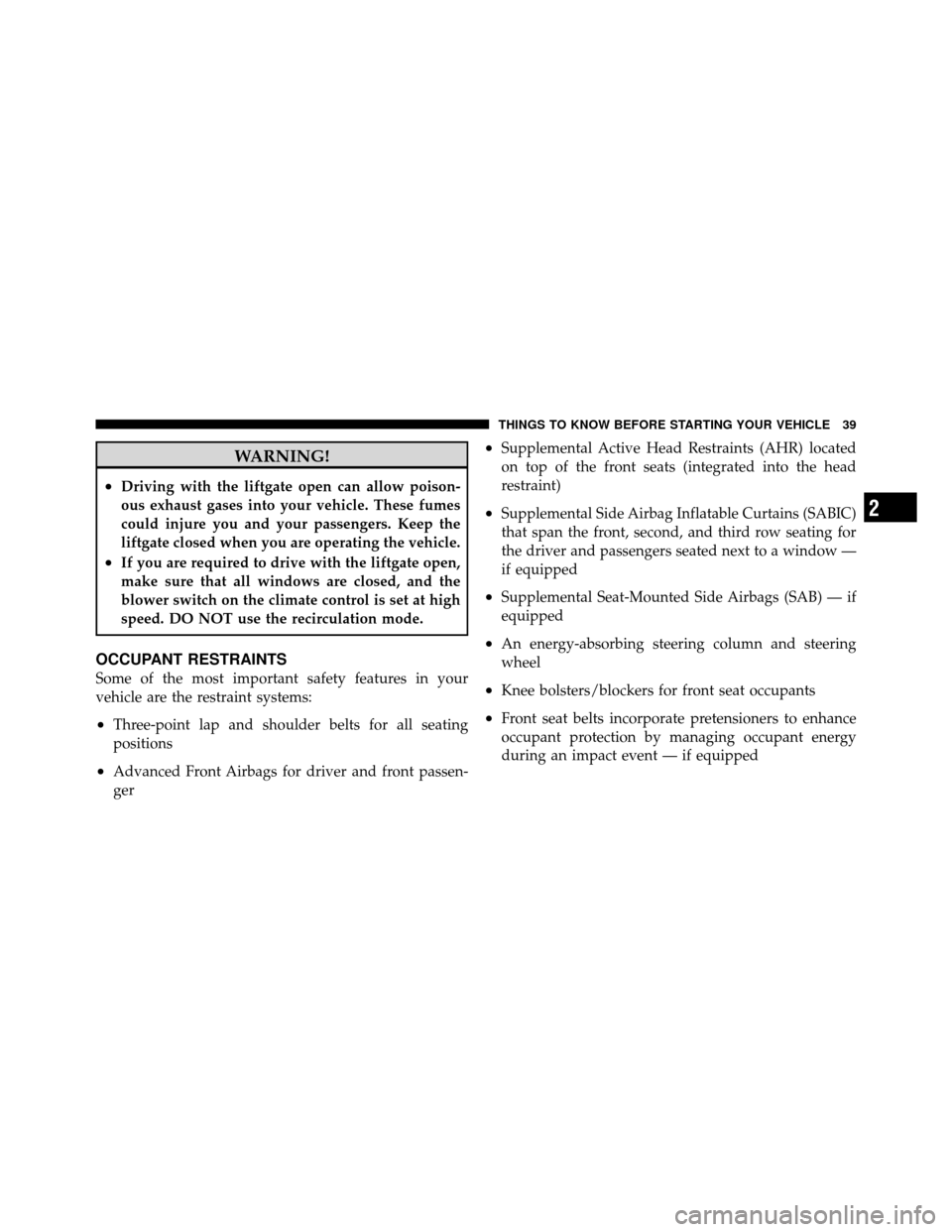
WARNING!
•Driving with the liftgate open can allow poison-
ous exhaust gases into your vehicle. These fumes
could injure you and your passengers. Keep the
liftgate closed when you are operating the vehicle.
•If you are required to drive with the liftgate open,
make sure that all windows are closed, and the
blower switch on the climate control is set at high
speed. DO NOT use the recirculation mode.
OCCUPANT RESTRAINTS
Some of the most important safety features in your
vehicle are the restraint systems:
•Three-point lap and shoulder belts for all seating
positions
•Advanced Front Airbags for driver and front passen-
ger
•Supplemental Active Head Restraints (AHR) located
on top of the front seats (integrated into the head
restraint)
•Supplemental Side Airbag Inflatable Curtains (SABIC)
that span the front, second, and third row seating for
the driver and passengers seated next to a window —
if equipped
•Supplemental Seat-Mounted Side Airbags (SAB) — if
equipped
•An energy-absorbing steering column and steering
wheel
•Knee bolsters/blockers for front seat occupants
•Front seat belts incorporate pretensioners to enhance
occupant protection by managing occupant energy
during an impact event — if equipped
2
THINGS TO KNOW BEFORE STARTING YOUR VEHICLE 39